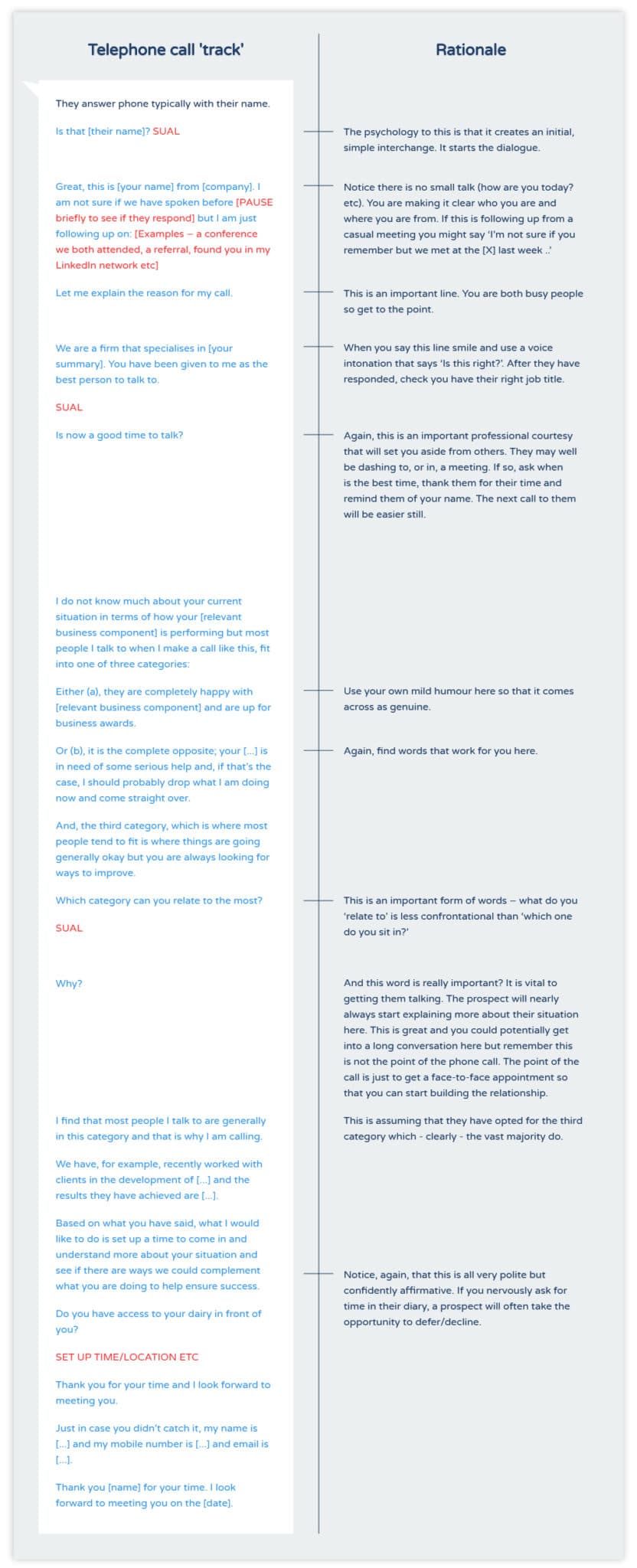The dreaded sales call - Mindset and Headset ready - From A-6 to A-5 - The importance of SUAL - Tweak the track - Buddy up - A transference of enthusiasm - Defend this time
Last week’s essay explored how you can make the most of the many, everyday, informal opportunities you get to start a sales dialogue. This week I explore how best to go about more deliberate early conversation: first contact through a sales call.
Ah … the dreaded phone sales call. It’s amazing what a bad rap this activity gets. Of course, we all hate the calls from some distant call centre peddling unwanted services or, worse, patronising us with social small talk up-front. I seek first, therefore, to adjust your mindset away from this common experience and negative perception. The best professional service sellers know the importance of making such first-contact voice calls and the preparation required therein.
Now, it is true that the art, and science, of selling evolves over time. It is fair to say that an onus on marketing to pull prospects towards your unique expertise and offering is stronger now than it was, say, five years ago (with an increasing number of platforms that can help facilitate this discipline). It is also fair to say that the proliferation of other first contact channels (LinkedIn etc) means that voice contact moments are harder to initiate. That all said, if you speak to the best in the game they still place as much emphasis on the sales call – as a critical step of the relationship-build process – as they always did. Why? Because having a professional voice conversation is of a human, qualitative bound above marketing content or static first contact (emails etc) – in the context of stepping you closer towards a face-to-face, professional-to-professional discussion.
Climbing Mount Audacity…
From Startup to Scaleup!
We're sharing everything we know about how to build an awesome professional service firm (and enjoy the journey en route!) PLUS travel updates, reflections on our stumbles and general musings on our Method Grid journey.
Signup below to get the latest articles
direct to your inbox.
Of course, building a relationship is best done by meeting in person. With professional service sales, prospects will often hold back on making a final assessment of someone until this physical encounter. But, on the step-by-step journey to get to this point, a voice conversation (phone/Skype etc) just happens to be one of the best ways of bringing this moment closer.
Mastering the sales call
In terms of mindset, therefore, be clear that this first sales call is about a polite introductory conversation between professionals. You will be straight and to the point, with no false bonhomie or “How are you today?” type chat. You are simply seeking to find out a bit more about the current situation in determination of whether your service can be of value to them. Indeed, even the term sales call maybe best avoided – you are not selling per se, you are just seeking, as mutually relevant, to coordinate a future face-to-face meeting. I would certainly ban the phrase cold calling. This is full of negative connotation – especially so with respect to the worst business-to-consumer sales techniques; conversely, there will always be some initiating, professional logic as to why you are reaching out.
Very quickly, with that mindset adjustment, you will genuinely find yourself enjoying such conversations. Yes, you occasionally get to speak to a terse malcontent but you soon learn that these are in a very, very small minority. The vast majority of people you speak to are intelligent, professional folk. Even if it transpires your services are not relevant to them, they are predominantly pleasant conversations. Soon you will find yourself caught up in the thrill of the chase of this … it becomes genuinely intriguing to know how each call is going to develop.
The first fundamental point, therefore, is to get your head in the right place for such activity. Whilst you should always be actively marketing (and hoping for that rare unsolicited approach or client referral) the simple reality is that this sales call step, done well, is the most productive game changer in your sales toolbox.
If your attitude towards the sales call is 70% of the equation, the final 30% is your method and technique. This, again, is something to harmonise across the firm such that colleagues have the one way of doing this on which to share practical experience and peer coach.
What I want to cover now, therefore, is an example track of such a sales call. I know what you are thinking … this is getting worse, I can’t possibly read from a script. It is exactly what I thought when first learning from a master sales professional many years ago. This is a natural first reaction but – believe me – this will be an invaluable aid; once practiced, it doesn’t sound unnatural at all and it prevents the spontaneous, nervous ad lib which invariably doesn’t end well.
Again, my implore to you is to tweak this example sales call track for your own circumstance (whilst recognising there are many subtle elements within it that are there for a reason). Before we explore this example, I should reiterate that this is primarily about taking leads at the A-6 category of the people pipeline (see the sales pipeline blog) and moving them to an A-5 (meeting booked). It is an incredibly important stage. Can you imagine if the majority of your team all put aside a few hours each month to generate two meetings each … what a difference that would make to your sales down the line!
I should also say that this activity needs to sit within a broader strategy; for example a campaign to seek to do more business within a certain sector within a certain region. You might therefore have a set of leads already generated by your marketing function (and stored in your contact management system) or you might, within this overall strategy, be actively searching for leads as you go. With the prevalence of online search, generally, and professional networking tools (e.g. LinkedIn), specifically, this is easily done. You should, of course, apply some intelligent qualification to this step but as soon as you feel you might have found someone worth talking to, it’s really a case of just getting on with it.
So, here’s an example sales call track that, from personal experience, has generated hundreds of meetings and, more importantly, some great, enduring client relationships (that first contact moment long since forgotten!).
Oh, before you get into it … please note one of the most important acronyms you will see in this context is SUAL. It stands for: shut up and listen!

Figure: An example request-for-meeting sales call track
ACTIVITY
You will want to craft such a track tailored to your offering. it will, no doubt, be tweaked further as you test and adjust it with the experience of early calls. Schedule some time – very soon – to have a go at both producing this and, most importantly, at putting it to work.
TOP TIPS
Even with a positive mindset and a great track, consistently applied, the difference between limited success and high conversion can be a nuanced affair. I learnt numerous top tips after years of practice and collegial support from others that made a huge difference in this regard. No book will convey all of these so don’t expect early mastery; it really is a case of learning-by-doing. That all said, what follows is a sprinkling of ideas to get you going:
Try and buddy-up with a colleague in joint call sessions in order to listen to each other as this really helps build confidence and competence.
Your body position and language is really important. Buy a headset so that you are comfortable and can take notes as you speak (into your CRM system). Stand up and consciously smile going into the call. At the very least sit up straight; put your body into a productive state. Remember sales is primarily a transference of enthusiasm.
Concentrate on the tone and tempo of your voice. Don’t rush the words out. Even though you may never have met the person, always position them psychologically as a peer and adopt a gentle timbre that encourages dialogue.
Ban the term cold calling in your firm. It carries all the negative inferences of this activity. You are not selling windows, you are just starting the process of making professional relationships.
Harness professional networking tools such as Linkedin. These are invaluable for generating leads and introducing yourself as someone connected via a mutual acquaintance is a well-accepted entree.
Block out time for this activity and treat it as importantly as time with a client. You wouldn’t cancel a senior-client meeting just to progress more emails, so don’t let this type of excuse disrupt scheduled sales call time either.
Dealing with blockers (PAs, receptionists etc) can become an art in itself. One tip is to finish a request to be put through with a polite and firm “Thanks” before they have had time to refuse. Ask for a mobile number; you will be surprised how often this is given. if they remain in the way, just politely ask them for their name and get off the call (you can seek to disarm them at a later point).
The most productive times of the day for calling can be the hours before 09.00 when busy executives are in their offices, preparing for the day ahead (before their PA arrives). Similarly, lunchtime and the hours just after 17.00 before it gets too unsociably late to make a business call.
You should always politely push back if just asked to send over an explanatory email. Say something like: “I would be happy to do that – but – if you are anything like as busy as me, I doubt you will get time to read it. I would prefer to set up a meeting to find out more about your situation. If you need more information on us in the interim then our website is as follows […].” At the very least, seek to get another time for a less rushed call. Of course, on occasion, it is the only way to progress the dialogue, but resorting to email typically lowers the chances of progression significantly – so never acquiesce to this immediately.
Remember the purpose of the first contact sales call is just to set up a meeting … nothing more.

 Project and Program Management
Project and Program Management  Project Governance Framework
Project Governance Framework  Benefits Management Framework
Benefits Management Framework 






